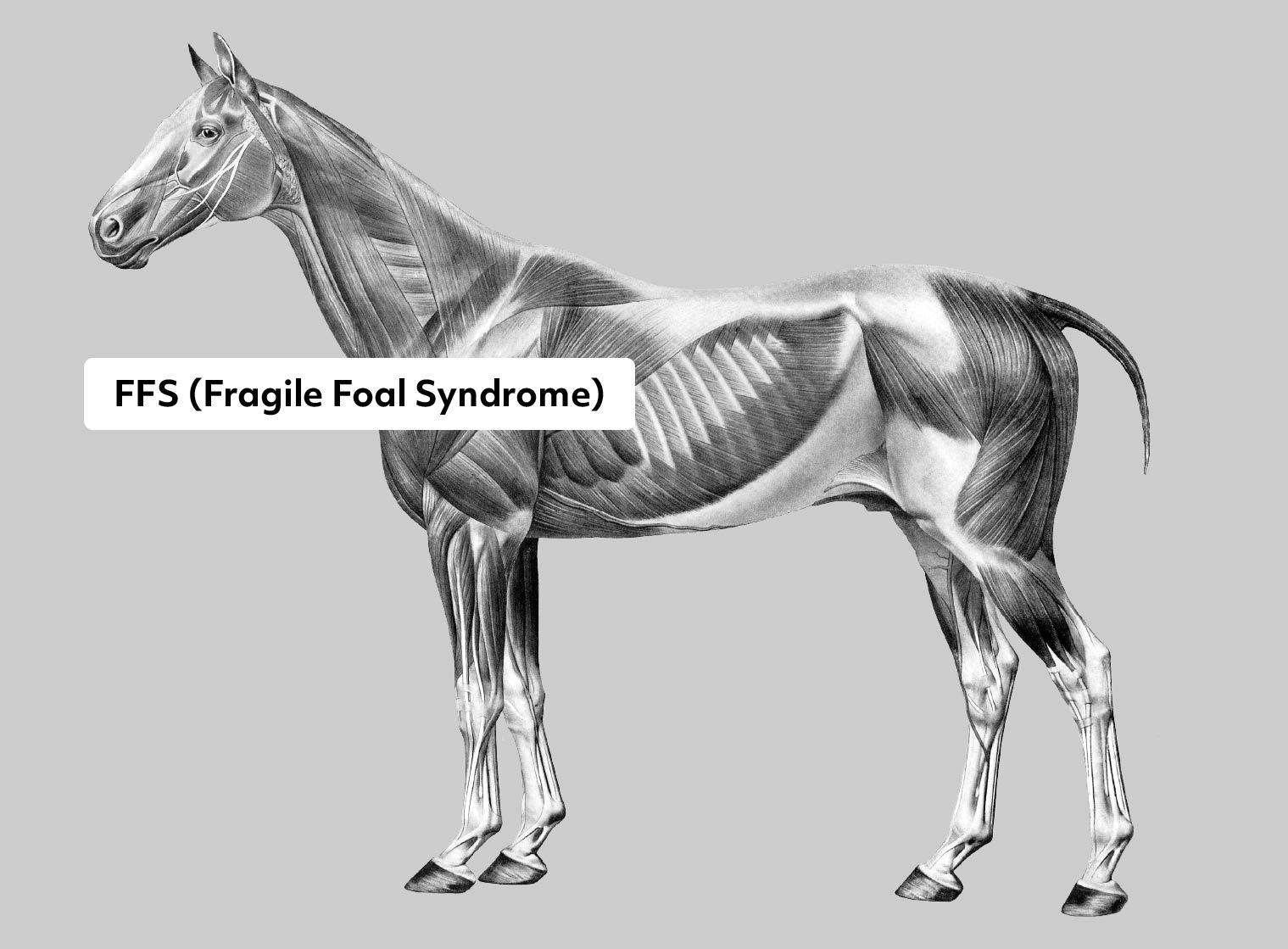"Warmblood" Fragile Foal Syndrome (ffs)
Gene or Region: PLOD1
Reference Variant: C
Mutant Variant: T
Affected Breeds: Warmblood and Other Breeds
Research Confidence: High - Findings reproduced multiple studies
Explanation of Results: ffs/ffs = homozygous for Fragile Foal Syndrome, trait expressed ffs/N = heterozygous for Fragile Foal Syndrome, carrier N/N = no variant detected
Warmblood Fragile Foal Syndrome: Genetic Testing and Health Insights for Horse Breeders
Fragile Foal Syndrome is a connective tissue disorder resulting in joint laxity and extremely thin skin that is only loosely connected to the body. The skin is easily torn, resulting in lacerations, hematomas, and seromas across the foal. Affected foals are euthanized shortly after birth. As Fragile Foal Syndrome is a recessive disorder, horses must inherit two copies (ffs/ffs) to show the disease. Horses with only one allele (ffs/N) are known as carriers due to their ability to produce affected offspring.
Learn more about Warmblood Fragile Foal Syndrome here.
Gene Information
PLOD1 is an enzyme involved in collagen synthesis. Mutations in mice and humans result in similar connective tissue disorders. The mutation observed in horses alters an amino acid, likely disrupting the function of the encoded protein.
References
Kehlbeck, A., Blanco, M., Venner, M., Freise, F., Gunreben, B., & Sieme, H. (2024). Warmblood fragile foal syndrome: Pregnancy loss in Warmblood mares. Equine veterinary journal.
Smythe, M., Dewberry, S., Staiger, E. A., Allen, K., & Brooks, S. (2023). 45 Quantifying gait quality changes in fragile foal syndrome carriers using artificial intelligence. Journal of Equine Veterinary Science, 124, 104347.
¹ Martin, K., Brooks, S., Vierra, M., Lafayette, W. T., McClure, S., Carpenter, M., & Lafayette, C. (2021). Fragile Foal Syndrome (PLOD1 c.2032G>A) occurs across diverse horse populations. Animal Genetics, 52(1), 137-138. https://www.researchgate.net/publication/345638537_Fragile_Foal_Syndrome_PLOD1_c2032GA_occurs_across_diverse_horse_populations
² Rahael, H., Smythe, M., Dewberry, S., Oberdorfer, A., Allen, K., & Brooks, S. (2023). 44 Detecting conformational differences in Fragile Foal Syndrome carriers utilizing artificial intelligence. Journal of Equine Veterinary Science, 124, 104346. https://doi.org/10.1016/j.jevs.2023.104346
³ Smythe, M., Dewberry, S., Staiger, E., Allen, K., & Brooks, S. (2023). 45 Quantifying gait quality changes in fragile foal syndrome carriers using artificial intelligence. Journal of Equine Veterinary Science, 124, 104347. https://doi.org/10.1016/j.jevs.2023.104347
⁴ Bellone, R. R., Ocampo, N. R., Hughes, S. S., Le, V., Arthur, R., Finno, C. J., & T. Penedo, M. C. (2020). Warmblood fragile foal syndrome type 1 mutation (PLOD1 c.2032G>A) is not associated with catastrophic breakdown and has a low allele frequency in the Thoroughbred breed. Equine Veterinary Journal, 52(3), 411-414. https://doi.org/10.1111/evj.13182
Monthoux C et al., “Skin malformations in a neonatal foal tested homozygous positive for Warmblood Fragile Foal Syndrome.” (2015) BMC Vet Res. 11: 12. PMID: 256373371.
More Horse Health
Androgen Insensitivity Syndrome
Androgen Insensitivity Syndrome (AIS) is an X-linked disorder of sexual development resulting in a female horse with XY chromosomes. Horses with AIS exhibit stallion-like behavior such as agression toward other horses, Flehman response and vocalization toward cycling mares.
Cerebellar Abiotrophy
Cerebellar Abiotrophy (CA) is a degenerative neurological disorder, due to the death of neurons in the brain. Symptoms (head tremors, lack of coordination, wide stances, exaggerated gain, difficulty rising and startling easily), typically appear in foals between six weeks and four months of age.
Chronic Idiopathic Anhidrosis Risk
Chronic Idiopathic Anhidrosis Risk (CIA) is the inability to sweat in response to increased body temperature, (AKA "non-sweater"). This condition is dangerous and sometimes life-threatening for horses, who rely on sweating for 65-70% of their temperature regulation.
Congenital Stationary Night Blindness 2
Congenital Stationary Night Blindness (CSNB) is an inherited disorder in horses characterized by an inability to see in low-light or dark conditions. This condition is present from birth and does not worsen over time. Common indicators include a horse’s reluctance to enter dark environments, difficulties in locating food and water in the dark, and a propensity for nighttime injuries.
